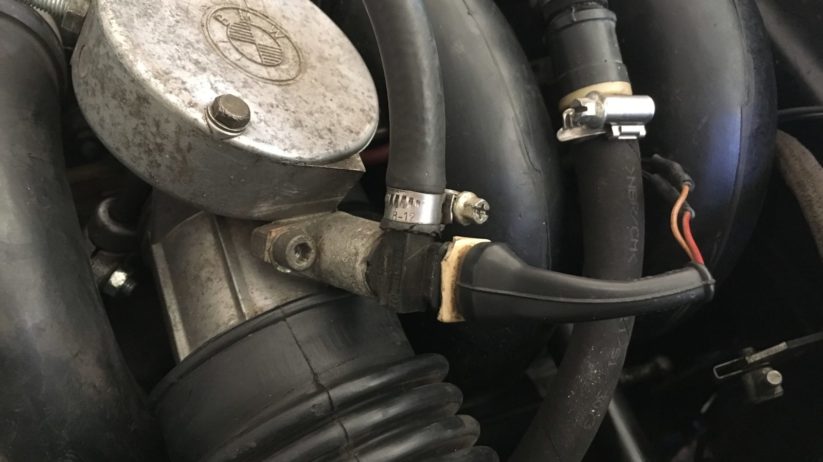In the summer of 2015, I wrote a series of articles (“A Funny Thing Happened On The Way To The Vintage”) about fixing Brian Ach’s 2002tii after it began running horribly on a road trip to Winston-Salem. The root cause turned out to be that the #4 fuel injector had a broken spring, making it just dribble fuel instead of spraying it. I’ve still never met anyone else who has ever seen this happen.
I hark back to, as I sometimes refer to it, l’affaire de Brian Ach, because it was one of the most satisfying automotive things I’ve ever done. The reason why is the eureka moment.
I’m not alone. There’s a great scene in the movie Interstellar, where, after Murph solves a previously intractable gravity equation (which in turn leads to the salvation of humanity), she throws her papers over a balcony and shouts, “Eureka!” She then shrugs, says to her boyfriend, “It’s traditional,” kisses him, and does it again. It’s a beautiful moment. And that’s how I felt when I finally fixed Brian’s car: freaking eureka! It was exquisite. Satisfying. Joyous. Perfect. And exceedingly rare.
Most of our daily lives consist of routine. We rarely get to put the focus on solving oddball problems, and even if we do, it’s unusual that the root cause is something so unexpected, so out-of-the-box that when we find it, our mind does that glorious flower-like unfolding of understanding, where you can just feel the neurons making connections. Plus, as do-it-yourself mechanics, even if that does happen, the joy is usually scuttled by the fact that the cause was some doofus-level thing that we brought on ourselves. Or, even if we’re not guilty of creating the problem, often it has been going on for so long, and the process of diagnosis has been so tortured, that when the cause finally reveals itself, our response isn’t, “Eureka” but is instead, “That? That was the problem? I am such an idiot. I should’ve found that weeks ago.”
And with that introduction, here’s the story of fixing a vexing cold-start problem on Kugel, my Chamonix ’72 tii.
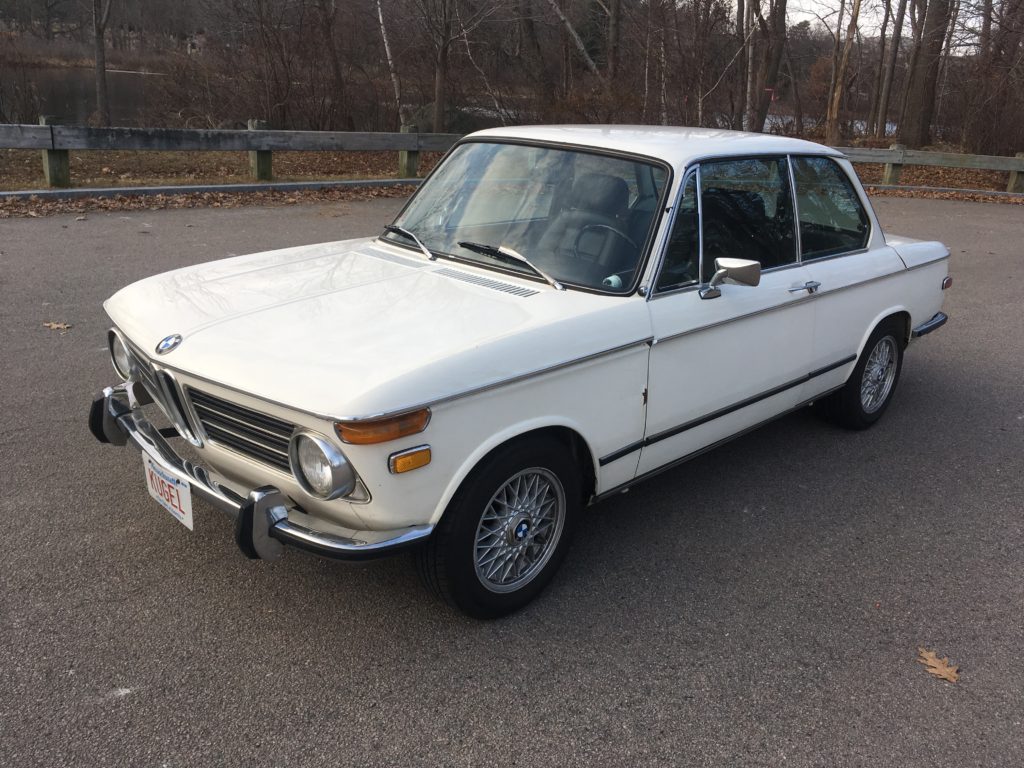
Kugel has been a great car, but maddeningly difficult to cold-start.
I don’t recall exactly when the problem crept in, but the car had had it for years. When the engine was warm, it’d fire up immediately, but when it was cold—and I don’t even mean cold-weather cold, just first-thing-in-the-morning cold—you’d need to crank and crank and crank it to get it to start. This description immediately implicates the cold-start circuit.
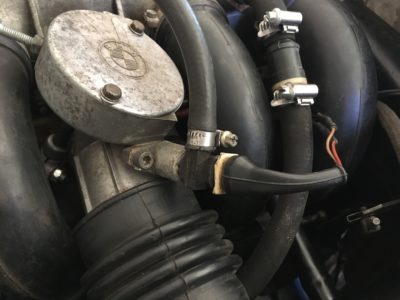
The cold-start valve has to spray atomized fuel for a tii to start easily.
Tii’s need a fine mist of atomized fuel to start when cold, more than can be delivered by the injectors. This extra fuel is provided by a cold-start valve at the top of the throttle body. It’s switched on by a thermo-time switch about the size of a pack of cigarettes that’s located on the firewall, next to the fuse box. The thermo-time switch reads the voltage from the temperature sensor; when you crack the starter, it sprays fuel through the cold-start valve for from one to five seconds, depending on how cold it is.
The problem is that the thermo-time switch is now a 45-year-old piece of tii-specific electronics. They fail, and they’re very expensive to replace. So when they malfunction, I—and many other tii owners—simply bypass them with a push-button or a toggle switch that essentially acts like a manual choke. Wire the switch to a source of voltage and to the valve, hit the switch while you’re cranking the engine: It sprays the fuel mist, the spinning starter rotates the engine which draws the fuel in, and Bob’s your uncle.
I wired such a switch in Kugel years ago on the panel above my left knee. I recall that it used to work, but for some reason the car’s cold-start problems returned.
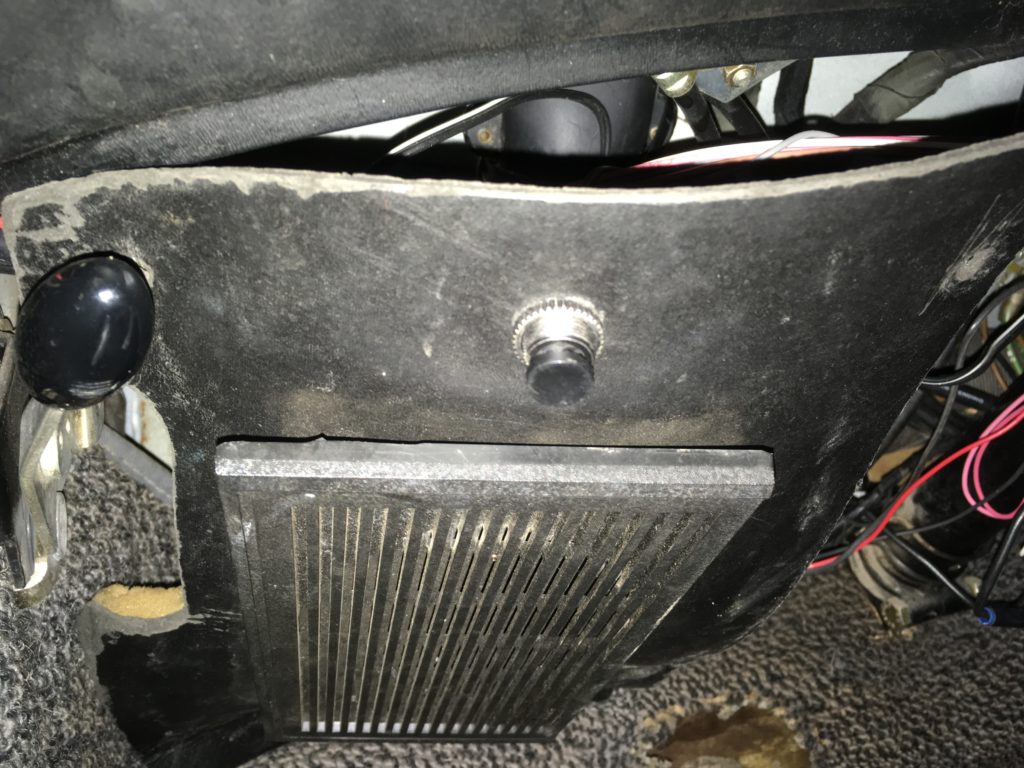
This $2 push-button switch bypasses…
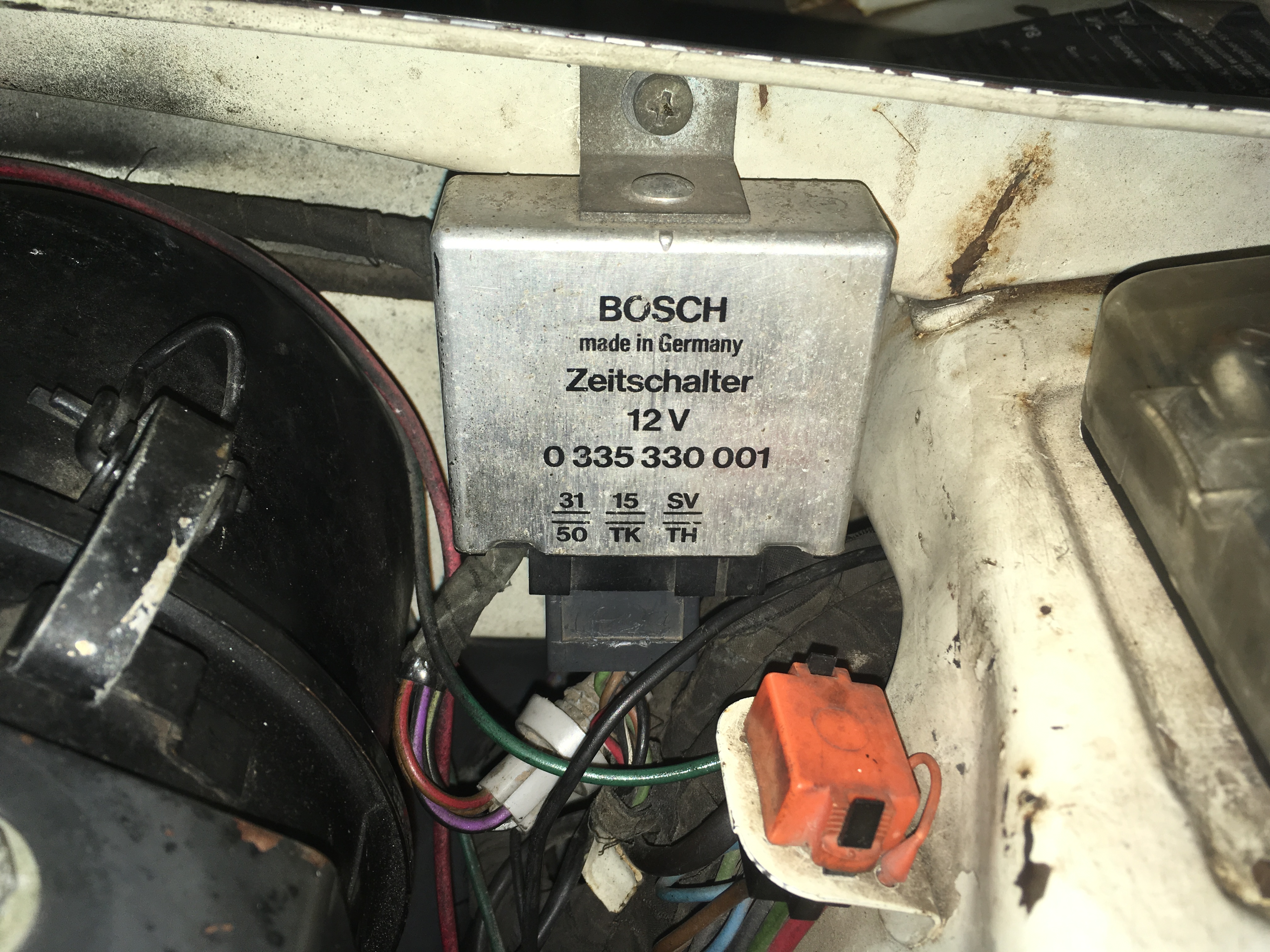
…this $275 thermo-time switch.
The exact symptomology of Kugel’s hard-starting was a little unusual. I’d crank the starter in five-second bursts while pushing the cold-start button. On around the sixth or seventh try, the engine would begin to burble; on each successive burst, it would burble a little more, and eventually it would start. Through trial and error, I found that, if I mashed the cold start button before cranking, and partially depressed the accelerator pedal to open the throttle and allow the atomized fuel sprayed by the cold start valve to be drawn into the engine easier (a known trick in the tii world), it would help— but even doing this, it was rare that the car would start easily.
Last year, before I’d sent Louie, my nearly-identical ’72 tii, on its 10-month stay at the BMW CCA Foundation museum in Greer, I swapped nearly every ignition component (distributors, coils, plug wires, Pertronix for points) as well as cold-start valves between the two cars. None of it improved Kugel’s cold starting. I wrote a lengthy post on bmw2002faq about the problem. When someone would comment, “Have you checked the cold-start valve?” I’d get annoyed. Of course I checked the cold-start valve. I have it wired to a push-button. It sprays. It’s bullet-proof. Didn’t you read my post? Whatever was going on, it wasn’t trivial.

Obviously created during one of my less-optimistic moments.
Twice I thought I’d solved the problem. The first time, I found that the center contact of the distributor cap was damaged. I replaced the cap. The second time I realized that the starter itself was dying and spinning increasingly slowly. I replaced it with one of those $70 eBay fast-spinning gear-reduction starters for an M30 engine. Both repairs helped it, but did not solve the problem. It was vexing enough that, at some point, I made this somewhat dark meme.
As winter’s cold temperatures descended and I needed to shuffle cars between storage areas, I was confronted by how hard Kugel really was to start in the cold. So last week, with Bertha safely stored for the winter and the punch list on the Lama down to non-essential items, I decided that it was time to diagnose and fix Kugel’s persistent cold-start issue once and for all.
Now, to me, part of the joy of working on vintage cars is that, due to the cars’ simplicity, nearly all problems can be diagnosed and fixed. As with many starting or running issues on vintage cars, it usually comes down to spark or fuel.
I began with fuel. I verified that the fuel pump spun when I turned the key to the ignition (“run”) setting, and that it produced the correct fuel pressure. I could hear the solenoid in the cold-start valve snap open when I pushed the button, and I could see gas dribbling out from the throttle body if I took the rubber bellows off. Just to be certain, I unbolted the valve from the throttle body, aimed it into a container, turned the key to ignition, pushed the button, and verified that it created a fine mist of gas. From all this, I had zero doubt that the cold-start valve was operating properly.
So I turned my attention to the ignition system. I verified that the coil was getting power when the key was turned to ignition. Like most 2002s, Kugel has a ballast resistor in line with the coil, where the ballast resistor is bypassed during starter cranking. Due to the impedance of the ballast resistor, when the key is on ignition, you don’t see the full 12.6 volts at the coil; you see about 9.6 volts. While cranking, the resistor is bypassed, but due to the high current load from the starter spinning the engine, it draws the voltage down, so you usually also see about 9.6V. Both of these readings looked fine on Kugel.
I put a test light across the 15 and 1 terminals of the coil and verified that it flashed while I cranked the starter, so not only was the coil getting voltage during cranking, it appeared to be firing.
Next, I directly checked for spark. It’s easiest to have a friend turn the key and crank the starter while you hold the coil wire close to ground, but you can do it yourself if you have a remote-start switch. I removed the wire going to the starter solenoid and connected the remote-start switch between there and the battery, allowing me to start the car from under the hood. I turned the key to ignition, disconnected the wire from the center of the distributor, grabbed it with rubber-handled pliers, held it 1/4″ from a strut-tower stud, squeezed the remote-start switch, and saw a good strong blueish spark. I then pulled off a plug wire, took a spare spark plug, inserted it, held that against ground, and verified that spark was reaching the plugs.
Fuel looked good, ignition looked good. So what could be the problem?
I went back to fuel. I often use starting fluid to help categorize starting problems as fuel or ignition-related. If you give a car a good blast of starting fluid into the intake while cranking and it fires up but dies a few seconds later, it likely means that you have spark but no fuel (often a dead fuel pump), but if it won’t fire up with starting fluid, it usually means that you don’t have spark. However, starting fluid—and atomized fuel sprayed by the cold-start valve itself—needs to be drawn into the engine by cranking it over with the starter and having the cylinders and valves draw it in. It’s not nearly as effective if you spray it into a non-running engine and then leave the engine compartment and go inside the car and turn the key.
So I stood next to the engine compartment, blocked open the throttle plate with the handle of a screwdriver, and sprayed starting fluid while hitting the remote start switch. The car started easily and kept running. This was progress, but it didn’t clearly implicate either fuel or spark. If anything, it pointed to the cold-start valve, and I’d already tested that.
The next morning (remember, to catch it in the act, each time I needed to test a dead-cold engine), I went out to the garage. Because the remote-start switch was still connected, I stretched the wires into the car, turned the key to ignition, and hit both the remote start switch and the cold-start button. To my surprise, Kugel snapped right to attention.
What the—?!
I repeated the test four times on a dead-cold engine to be certain. Each time the results were the same: When I cranked the starter with the key while hitting the cold-start push button, the car only started with great difficulty, but when I used the remote-start switch instead, it fired up easily. This was a major clue. But what did it mean?
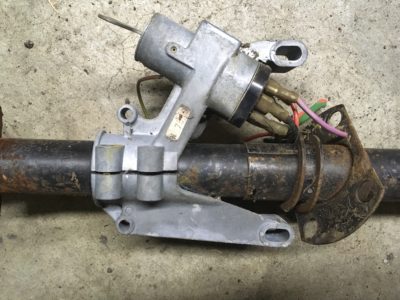
I have a spare ignition-switch assembly, but it’s not easy to replace.
My first thought was that the problem was in the ignition switch on the steering column. I have a spare switch, but swapping the assembly between columns is a bit involved. I checked the terminals for continuity and didn’t find anything wrong, but I accepted the possibility that there could be a voltage-drop issue while cranking. For example, was the fuel pump cutting out while the key was turned to start? I put a voltmeter on Fuse #11 for the fuel pump and cranked the starter, and saw no voltage drop there.
Even though there seemed to be plenty of spark, I carefully examined the starting relay (the one bolted to the firewall behind the coil). I realized that this was the one ignition component I hadn’t swapped with Louie. I checked that the relay was wired properly. I verified that it worked correctly. I substituted a spare. It made no difference. The purpose of the relay is simply to bypass the ballast resistor during cranking, so just to be absolutely certain, I hot-wired the 15 terminal of the coil directly to the battery. That made no difference, either.
Boy, though, I felt that I was close. The act of cranking the starter with the ignition switch was causing something to cut out; I just needed to figure out what and why. As I sometimes do when I’m in diagnostic hell, I wrote up notes in Excel. There was a note that said, “Verify that cold-start valve is actually spraying while cranking.” It seemed like a formality; I knew that it was. But I didn’t know what else to try. So I took an empty orange-juice bottle, went out to the garage, positioned a fire extinguisher at the ready, again unbolted the cold-start valve from the throttle body, put the valve in the bottle, put the pair where I could see them from inside the car, got in, turned the key to ignition, pushed the cold start button, and watched as the valve sprayed perfectly into the bottle.
Then, with the cold-start button still pressed, I twisted the key further to crank the starter. The cold-start valve stopped spraying while the starter was cranking. Gotcha. Eureka!
But why?
I looked at how I’d wired the cold-start push-button. As with the radio, the air-fuel meter, and the oil pressure gauge, the push-button was drawing power off the accessories terminal of the ignition switch, the one with the purple wire on it.
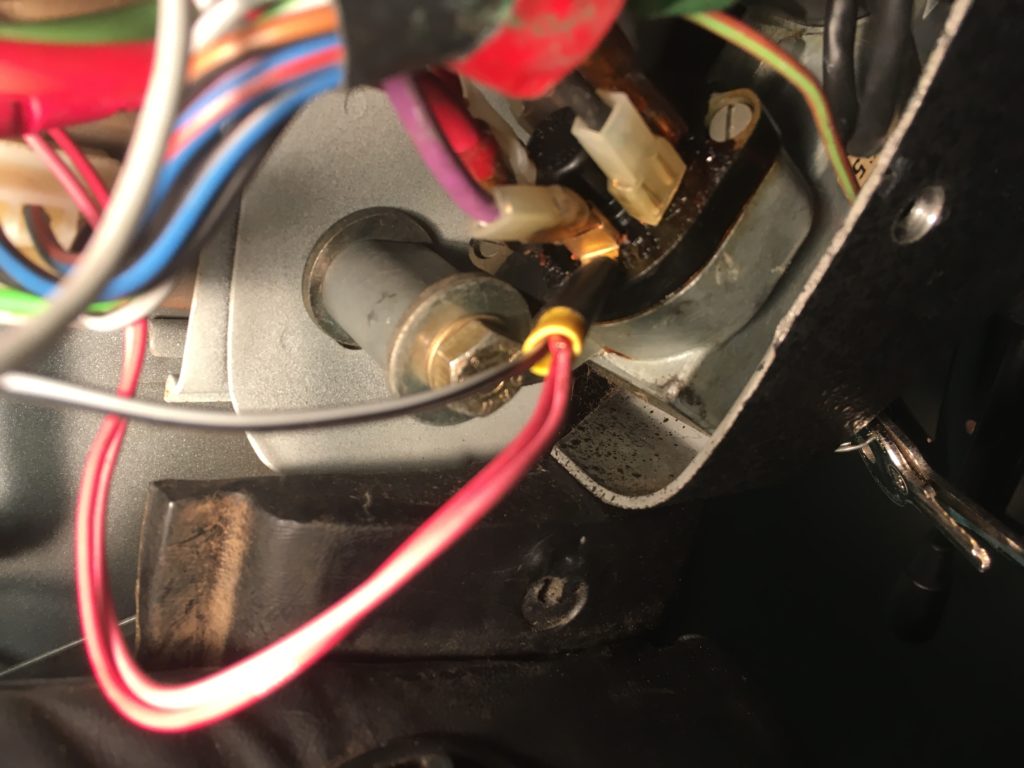
I had multiple things connected to the ignition switch’s accessories terminal (purple wire).
And then it hit me. Does the radio on a 2002 stay on while you’re cranking the starter? No, it doesn’t. I grabbed the voltmeter and verified that the accessories terminal received voltage when the key was turned to ignition, but that the voltage cut out when the key was cracked to start.
So, just to be clear about this, at exactly the time that the starter was spinning the engine to draw the fuel mist sprayed by the cold start valve into the cylinders, voltage to the valve was being cut off, and the valve stopped spraying. This made absolutely perfect sense. I experienced a second eureka. I changed the wiring so that the push-button received voltage from the same circuit as the fuel pump, and the problem completely went away.
But then, eureka morphed before my eyes into I am such a big doofus, because I was the one who had wired the cold-start button to the accessories terminal. I had to think about why; I’d probably installed six of these into tiis over the years, and none of the others had this problem. It was possible that I’d had it working on Kugel but switched the wire to the accessories terminal when I installed the air/fuel and oil-pressure gauges.
I was so certain that the cold-start valve was working properly, I’d dismissed it as a possible problem culprit. The big takeaway here is that whenever you think, “It can’t be that,” a light should go off in your brain telling you to take your blinders off. I’ve learned this lesson before. Looks like I needed to learn it again.
But even so, finally diagnosing, understanding, and fixing Kugel’s cold-start problem, completely, once and for all, was the best holiday automotive-related present I could’ve received.

Oh, who am I kidding? The best present would be elves reassembling the Lotus. Because otherwise….—Rob Siegel
Rob’s new book, Just Needs a Recharge: The Hack MechanicTM Guide to Vintage Air Conditioning, is available here on Amazon. His previous book Ran When Parked is available here. Or you can order personally inscribed copies of all of his books through Rob’s website: www.robsiegel.com.

